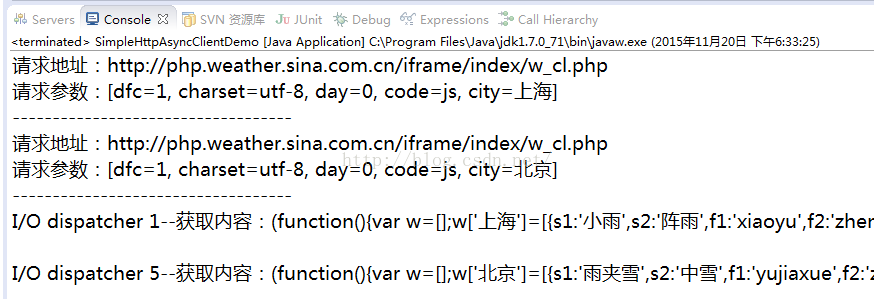文章16 | 阅读 6551 | 点赞0
轻松把玩HttpAsyncClient之模拟post请求示例
如果看到过我前些天写过的《轻松把玩HttpClient之模拟post请求示例》这篇文章,你再看本文就是小菜一碟了,如果你顺便懂一些NIO,基本上是毫无压力了。因为HttpAsyncClient相对于HttpClient,就多了一个NIO,这也是为什么支持异步的原因。
不过我有一个疑问,虽说NIO是同步非阻塞IO,但是HttpAsyncClient提供了回调的机制,这点儿跟netty很像,所以可以模拟类似于AIO的效果。但是官网上的例子却基本上都是使用Future<HttpResponse> future = httpclient.execute(request, null);来同步获得执行结果。
好吧,反正我是用回调的方式实现的。代码基本上跟httpClient那篇一致。不一样的地方主要有这么2个地方:配置ssl时不一样;调用execute方式时,使用回调。具体代码如下:
package com.tgb.ccl.http.simpledemo;
import java.io.File;
import java.io.FileInputStream;
import java.io.IOException;
import java.io.InputStream;
import java.io.InputStreamReader;
import java.io.Reader;
import java.security.KeyManagementException;
import java.security.KeyStore;
import java.security.KeyStoreException;
import java.security.NoSuchAlgorithmException;
import java.security.cert.CertificateException;
import java.util.ArrayList;
import java.util.HashMap;
import java.util.List;
import java.util.Map;
import java.util.Map.Entry;
import javax.net.ssl.SSLContext;
import javax.net.ssl.TrustManager;
import javax.net.ssl.X509TrustManager;
import org.apache.http.HttpEntity;
import org.apache.http.HttpHost;
import org.apache.http.HttpResponse;
import org.apache.http.NameValuePair;
import org.apache.http.ParseException;
import org.apache.http.client.ClientProtocolException;
import org.apache.http.client.entity.UrlEncodedFormEntity;
import org.apache.http.client.methods.HttpPost;
import org.apache.http.concurrent.FutureCallback;
import org.apache.http.config.Registry;
import org.apache.http.config.RegistryBuilder;
import org.apache.http.conn.ssl.TrustSelfSignedStrategy;
import org.apache.http.impl.conn.DefaultProxyRoutePlanner;
import org.apache.http.impl.nio.client.CloseableHttpAsyncClient;
import org.apache.http.impl.nio.client.HttpAsyncClientBuilder;
import org.apache.http.impl.nio.client.HttpAsyncClients;
import org.apache.http.impl.nio.conn.PoolingNHttpClientConnectionManager;
import org.apache.http.impl.nio.reactor.DefaultConnectingIOReactor;
import org.apache.http.impl.nio.reactor.IOReactorConfig;
import org.apache.http.message.BasicNameValuePair;
import org.apache.http.nio.conn.NoopIOSessionStrategy;
import org.apache.http.nio.conn.SchemeIOSessionStrategy;
import org.apache.http.nio.conn.ssl.SSLIOSessionStrategy;
import org.apache.http.nio.reactor.ConnectingIOReactor;
import org.apache.http.ssl.SSLContexts;
import org.apache.http.util.EntityUtils;
/**
* HttpAsyncClient模拟post请求简单示例
*
* @author arron
* @date 2015年11月1日 下午2:23:18
* @version 1.0
*/
public class SimpleHttpAsyncClientDemo {
/**
* 设置信任自定义的证书
*
* @param keyStorePath 密钥库路径
* @param keyStorepass 密钥库密码
* @return
*/
public static SSLContext custom(String keyStorePath, String keyStorepass) {
SSLContext sc = null;
FileInputStream instream = null;
KeyStore trustStore = null;
try {
trustStore = KeyStore.getInstance(KeyStore.getDefaultType());
instream = new FileInputStream(new File(keyStorePath));
trustStore.load(instream, keyStorepass.toCharArray());
// 相信自己的CA和所有自签名的证书
sc = SSLContexts.custom().loadTrustMaterial(trustStore, new TrustSelfSignedStrategy()).build();
} catch (KeyStoreException | NoSuchAlgorithmException| CertificateException | IOException | KeyManagementException e) {
e.printStackTrace();
} finally {
try {
instream.close();
} catch (IOException e) {
}
}
return sc;
}
/**
* 绕过验证
*
* @return
* @throws NoSuchAlgorithmException
* @throws KeyManagementException
*/
public static SSLContext createIgnoreVerifySSL() throws NoSuchAlgorithmException, KeyManagementException {
SSLContext sc = SSLContext.getInstance("SSLv3");
// 实现一个X509TrustManager接口,用于绕过验证,不用修改里面的方法
X509TrustManager trustManager = new X509TrustManager() {
@Override
public void checkClientTrusted(
java.security.cert.X509Certificate[] paramArrayOfX509Certificate,
String paramString) throws CertificateException {
}
@Override
public void checkServerTrusted(
java.security.cert.X509Certificate[] paramArrayOfX509Certificate,
String paramString) throws CertificateException {
}
@Override
public java.security.cert.X509Certificate[] getAcceptedIssuers() {
return null;
}
};
sc.init(null, new TrustManager[] { trustManager }, null);
return sc;
}
/**
* 设置代理
* @param builder
* @param hostOrIP
* @param port
*/
public static HttpAsyncClientBuilder proxy(String hostOrIP, int port){
// 依次是代理地址,代理端口号,协议类型
HttpHost proxy = new HttpHost(hostOrIP, port, "http");
DefaultProxyRoutePlanner routePlanner = new DefaultProxyRoutePlanner(proxy);
return HttpAsyncClients.custom().setRoutePlanner(routePlanner);
}
/**
* 模拟请求
*
* @param url 资源地址
* @param map 参数列表
* @param encoding 编码
* @param handler 结果处理类
* @return
* @throws NoSuchAlgorithmException
* @throws KeyManagementException
* @throws IOException
* @throws ClientProtocolException
*/
public static void send(String url, Map<String,String> map,final String encoding, final AsyncHandler handler) throws KeyManagementException, NoSuchAlgorithmException, ClientProtocolException, IOException {
//绕过证书验证,处理https请求
SSLContext sslcontext = createIgnoreVerifySSL();
// 设置协议http和https对应的处理socket链接工厂的对象
Registry<SchemeIOSessionStrategy> sessionStrategyRegistry = RegistryBuilder.<SchemeIOSessionStrategy>create()
.register("http", NoopIOSessionStrategy.INSTANCE)
.register("https", new SSLIOSessionStrategy(sslcontext))
.build();
//配置io线程
IOReactorConfig ioReactorConfig = IOReactorConfig.custom().setIoThreadCount(Runtime.getRuntime().availableProcessors()).build();
//设置连接池大小
ConnectingIOReactor ioReactor;
ioReactor = new DefaultConnectingIOReactor(ioReactorConfig);
PoolingNHttpClientConnectionManager connManager = new PoolingNHttpClientConnectionManager(ioReactor, null, sessionStrategyRegistry, null);
//创建自定义的httpclient对象
final CloseableHttpAsyncClient client = proxy("127.0.0.1", 8087).setConnectionManager(connManager).build();
// CloseableHttpAsyncClient client = HttpAsyncClients.createDefault();
//创建post方式请求对象
HttpPost httpPost = new HttpPost(url);
//装填参数
List<NameValuePair> nvps = new ArrayList<NameValuePair>();
if(map!=null){
for (Entry<String, String> entry : map.entrySet()) {
nvps.add(new BasicNameValuePair(entry.getKey(), entry.getValue()));
}
}
//设置参数到请求对象中
httpPost.setEntity(new UrlEncodedFormEntity(nvps, encoding));
System.out.println("请求地址:"+url);
System.out.println("请求参数:"+nvps.toString());
//设置header信息
//指定报文头【Content-type】、【User-Agent】
httpPost.setHeader("Content-type", "application/x-www-form-urlencoded");
httpPost.setHeader("User-Agent", "Mozilla/4.0 (compatible; MSIE 5.0; Windows NT; DigExt)");
// Start the client
client.start();
//执行请求操作,并拿到结果(异步)
client.execute(httpPost, new FutureCallback<HttpResponse>() {
@Override
public void failed(Exception ex) {
handler.failed(ex);
close(client);
}
@Override
public void completed(HttpResponse resp) {
String body="";
//这里使用EntityUtils.toString()方式时会大概率报错,原因:未接受完毕,链接已关
try {
HttpEntity entity = resp.getEntity();
if (entity != null) {
final InputStream instream = entity.getContent();
try {
final StringBuilder sb = new StringBuilder();
final char[] tmp = new char[1024];
final Reader reader = new InputStreamReader(instream,encoding);
int l;
while ((l = reader.read(tmp)) != -1) {
sb.append(tmp, 0, l);
}
body = sb.toString();
} finally {
instream.close();
EntityUtils.consume(entity);
}
}
} catch (ParseException | IOException e) {
e.printStackTrace();
}
handler.completed(body);
close(client);
}
@Override
public void cancelled() {
handler.cancelled();
close(client);
}
});
}
/**
* 关闭client对象
*
* @param client
*/
private static void close(CloseableHttpAsyncClient client) {
try {
client.close();
} catch (IOException e) {
e.printStackTrace();
}
}
static class AsyncHandler implements IHandler{
@Override
public Object failed(Exception e) {
System.err.println(Thread.currentThread().getName()+"--失败了--"+e.getClass().getName()+"--"+e.getMessage());
return null;
}
@Override
public Object completed(String respBody) {
System.out.println(Thread.currentThread().getName()+"--获取内容:"+respBody);
return null;
}
@Override
public Object cancelled() {
System.out.println(Thread.currentThread().getName()+"--取消了");
return null;
}
}
/**
* 回调处理接口
*
* @author arron
* @date 2015年11月10日 上午10:05:40
* @version 1.0
*/
public interface IHandler {
/**
* 处理异常时,执行该方法
* @return
*/
Object failed(Exception e);
/**
* 处理正常时,执行该方法
* @return
*/
Object completed(String respBody);
/**
* 处理取消时,执行该方法
* @return
*/
Object cancelled();
}
}来一个测试类:
public static void main(String[] args) throws KeyManagementException, NoSuchAlgorithmException, ClientProtocolException, IOException {
AsyncHandler handler = new AsyncHandler();
String url = "http://php.weather.sina.com.cn/iframe/index/w_cl.php";
Map<String, String> map = new HashMap<String, String>();
map.put("code", "js");
map.put("day", "0");
map.put("city", "上海");
map.put("dfc", "1");
map.put("charset", "utf-8");
send(url, map, "utf-8", handler);
System.out.println("-----------------------------------");
map.put("city", "北京");
send(url, map, "utf-8", handler);
System.out.println("-----------------------------------");
}测试结果如下:
很简单吧,其实基于HttpAsyncClient的工具类我也进行了封装,跟HttpClient工具类差不多。
代码都已经提交至:https://github.com/Arronlong/httpclientUtil。有兴趣的自行下载,博客中就不再分享了。
httpclientUtil (QQ交流群:548452686

)
版权说明 : 本文为转载文章, 版权归原作者所有 版权申明
原文链接 : https://longxuan.blog.csdn.net/article/details/49949813
内容来源于网络,如有侵权,请联系作者删除!
